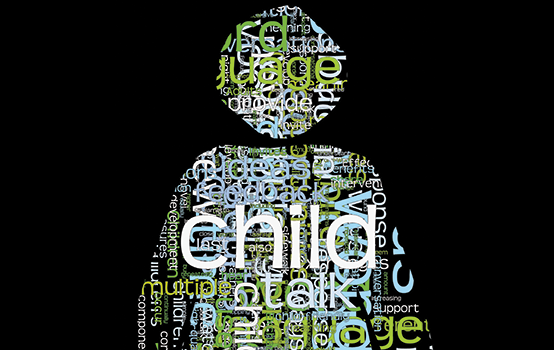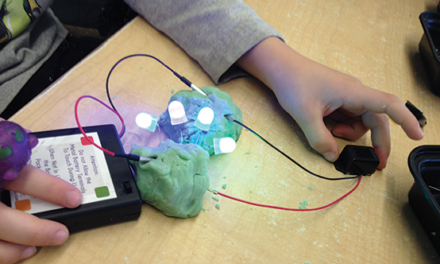 Research shows that the youngest children best learn words — the foundation for all learning yet to come — through repeated exposure and open-ended conversations with adults.
Research shows that the youngest children best learn words — the foundation for all learning yet to come — through repeated exposure and open-ended conversations with adults.
The 30-million word gap has received much attention recently in educational research and the popular press. Over $40 million has been invested in initiatives such as Providence Talks, the Thirty Million Words project, and Too Small To Fail to close the vocabulary gap between children in poverty and their middle-income peers. The focus of these programs is on increasing the quantity of talk to which children are exposed. However, we need to ask: Does evidence-based research on word learning show that the quantity of language matters most for children’s word learning, or do aspects of the quality of that talk play a substantial role as well?
The stakes of these projects are enormously high. If we’re trying to close the vocabulary gap with ineffective practices — including those that we know from cognitive science won’t work because they’re based on inaccurate assumptions — then our efforts will be unsuccessful, and some may conclude that the word gap cannot be closed and that children in poverty can’t learn. If this happens, the vocabulary achievement gap is destined to persist, as will the larger trend of pernicious inequity in education.
The 30-million word gap
The idea that a substantial vocabulary gap separates more and less affluent children comes from the groundbreaking research of Hart and Risley (1995; 1999; 2003) who observed 42 families of varied socioeconomic backgrounds and found that by age 3 children from low-income families had heard just half as many words as children from working-class families (616 words per hour vs. 1,251 words per hour), and less than one-third of those heard by children from high-income families (2,153 words per hour), a cumulative difference of about 30 million words over their first three years. Not surprisingly, the 3-year-olds in poverty used fewer overall words and fewer different words, and they also engaged in shorter conversations. Because language and vocabulary are essential for success in reading and all other content areas, by 3rd grade, these children showed lower performance on various vocabulary, language development, and reading comprehension measures. Thus, the earliest years of life have emerged as an essential period in which to foster vocabulary knowledge.
Adults need to provide wait time to give children time to formulate ideas and to express themselves.
How children learn words
Research shows that several principles describe children’s vocabulary learning (Biemiller, 2001; Booth, 2009; Harris, Golinkoff, & Hirsh-Pasek, 2011; Hoff, 2003; Wasik & Bond, 2001; Whitehurst & Lonigan, 1998).
#1. Children need repeated exposures to new words in order to learn them — sometimes as many as 200 exposures (Clay et al., 2007).
#2. These exposures are most helpful if they include explicit definitions of words, perhaps including a picture or prop.
#3. Children benefit when they can clearly connect a word’s meanings to their own background knowledge and experience. For example, a parent might say, “A zebra is similar to a horse, like the one we saw at the park last week, but it has a very special striped coat.”
#4. Children learn more new words when they’re presented in a meaningful context, rather than as isolated facts. For example, words could be introduced via a storybook reading and follow-up learning activities.
#5. Children learn words best when they’re exposed to a relatively high density of novel words relative to total words, likely because this introduces children to more novel terms and may draw their attention to words more generally (Huttenlocher et al., 1991). For example, in the Harvard Home-School Study children learned more new words when the adults around them used more complex vocabulary and inferential talk, such as predicting what might happen next in a story (Dickinson & Tabors, 2001).
#6. There is strong evidence that children benefit from the opportunity to use these words themselves and to receive specific feedback from adults on their understanding and pronunciation. This might include asking children to label things. For example, when encountering a zebra in a book, a parent might point to the picture of that animal and ask, “What’s this?” or “Is this a zebra?” — and then praise accurate responses or gently correct misunderstandings. More challenging are open-ended questions in which adults prompt children to use a new word in the context of a multiword response to which there is more than one right answer. For example, the same teacher could ask, “Tell me how a zebra is different from other animals” or “How would stripes help keep a zebra safe in its habitat?” Children would have the chance to share ideas about zebras, and, in group settings, hear peers share their ideas and receive feedback on the accuracy and clarity of their responses.
Conversations are key
The word-learning conditions described above are best met when children are engaged in conversations with adults. A conversation is a back-and-forth verbal exchange between two or more people during which each participant takes turns listening attentively to the other and contributing a related response. Conversations are most effective at building vocabulary if they’re extended and contingent, meaning that adults are actively recruiting and carefully scaffolding children’s talk about new words and ideas.
Specifically, word learning increases when adults invite children to use words for themselves and then provide meaningful feedback on children’s remarks over multiple conversational turns (Hirsh-Pasek & Burchinal, 2006). Further, responsiveness to children’s interests by talking with children rather than talking at them may be essential for extending conversations (Guttentag et al., 2014).
Interventions can help
Young children in poverty need opportunities to learn words while the word gap remains relatively narrow. Rich exchanges with adults, particularly conversations, serve as a key mechanism to accomplish this goal. To foster these interactions, technologies such as the LENA recording device, a self-described “talk pedometer,” are used to track parent-child interactions and to provide parents with systematic feedback on the amount of language exchanged with their child. (For more information, see www.lenafoundation.org.) But the quantity of talk represents only one piece of what is necessary to develop language and vocabulary in young children. Learning vocabulary absolutely requires talking, but some kinds of talk — especially those fostering high-quality interactions — will build vocabulary better than others.
Quality v. quantity
To understand how quality differs from quantity, examine the two parent-child exchanges below:
Exchange A:
P: Let’s get ready to go outside. Bring your ball.
C: OK. I got it.
P: Great job. Bring me your shoes next.
C: OK.
P: Let’s get them on and tie them up.
C: Then we’ll go to the park.
P: That’s right! You are such a great listener.
Exchange B:
P: Let’s get ready to go to the park. Bring your basketball.
C: OK. I got it.
P: Great job. Bring your red shoes next.
C: OK.
P: What will we see on the way to the park?
C: Maybe a school bus.
P: Tell me what a school bus looks like.
Although these two exchanges have almost exactly the same number of words, they differ substantially in quality. First, Exchange B allows the child to hear more precise language — basketball rather than ball, red shoes rather than shoes. Second, Exchange B allows the child more opportunities to talk, with two prompts that the child can respond to using multiple-word answers. Finally, Exchange B offers the child opportunities to think about and discuss more abstract ideas, going beyond the here-and-now.
High-quality conversation essentials
If the goal of an intervention is to support high-quality conversations, then the program should include the following components:
Child talk
Children need to talk in order to develop vocabulary and language. It may seem as though a young child talks all the time. However, in most conversations between adults and children, adults do most of the talking, ask questions that promote one-word responses, and often don’t respond in meaningful ways to what children say (Gest et al., 2006; Girolametto, Weitzman, & van Lieshout, 2000). For language development to occur, adults need to intentionally provide opportunities for children to talk in the following ways:
New vocabulary — Children need opportunities not only to hear new vocabulary words but to use the words in context. Interventions focused primarily on helping children learn new words without opportunities for children to use those words repeatedly over time won’t be as robust in increasing children’s vocabulary.
Wait time — Listening to children talk often takes time, as children think about what to say and search for the words to express their ideas. Adults need to provide wait time to give children time to formulate ideas and to express themselves. In busy lives, these language exchanges with children can’t occur each time we talk with children. However, providing these opportunities as often as possible is essential for scaffolding children’s vocabulary. Effective interventions should consider documenting the amount and quality of children’s talk.
Word learning increases when adults invite children to use words for themselves and then provide meaningful feedback on children’s remarks.
Adult talk
To develop vocabulary and language, children need adults to provide the following key components that contribute to high-quality conversations:
Open-ended questions — As above, open-ended questions invite more than a single-word response and generally have multiple possible correct answers. For example, “Did you watch TV last night?” is a yes/no question and “What show did you watch?” requires just one word in response. But, “What did you do last night?” could be answered in many ways, most of which involve multiple words and add meaningful, novel ideas to the conversation.
Quality feedback — Adults need to provide feedback that continually invites children to share their ideas (i.e., multiple conversational turns). Adult feedback on child language can take many forms. A yes or no response, which neither provides much new information detail nor invites more child talk, is among the simplest options. More beneficial for language development is asking for clarification (e.g., “Did you say dog?” or “Could you repeat that?”), providing some form of correction to the pronunciation of a word when children utter a close approximation, and offering feedback on grammatical accuracy.
Feedback on the meaning of a word is equally if not more important. If a child points to “bird” and says “bir,” a parent might respond, “Bird” (emphasizing the final sound) or even “Yes, that is a bird; let’s keep walking so we’re not late to school.” However, word learning would be further enhanced by hearing, “Yes, that is a bird; I think that’s a robin because of his red feathers” or “Yes, that is a bird; watch him gathering twigs to build a nest.” Although the word count in these last three exchanges may be about equal, the second and third exchanges clearly add more to the child’s understanding of “bird” by including complex words and associated information.
High-quality feedback also involves adults encouraging children to talk more. In Exchange B above, the adult asks the child to describe what he or she sees on the way to the park. That comment will invite a very different response than the “Let’s get them on and tie them up” reply in Exchange A. The turn-taking is the same, but the invitation to continue the conversations, share ideas, and use language is very different. Effective interventions need to support parents in following up on what children have said.
Focus on new words and their meaning — Vocabulary grows when adults explicitly define words in child-friendly, simply worded ways. An example of a child-friendly definition when defining the word robin is, “A robin is a small bird with orange feathers on its chest.” Vocabulary also benefits from explicit use of specific, descriptive language as often as possible to expose children to new ideas and to help them understand the world in greater detail. Children learn more new words when exposed to a higher density of novel terms. For example, when pointing out a robin on the sidewalk, a teacher could say, “That’s a robin hopping down the sidewalk” rather than simply, “There’s a robin over there.”
Multiple exposures to a word — Most words are learned gradually, through multiple different exposures over time. Often adults say a new word to a child once or twice and assume the child will remember. But vocabulary benefits from repeated opportunities to hear and use the word in meaningful contexts.
Connections to experience
Children need varied, first-hand experiences with the world in order to broaden the scope of the words and language that they use. Trips to the zoo, aquariums, and playgrounds can provide invaluable contexts for hearing and understanding words such as chimpanzee, shark, or swing. Unfortunately, a child’s range of experience may be narrowed by family economics. Although not a replacement for experiences, books can provide children with experiences and vocabulary that go beyond their everyday world. Although reading a book about a shark is not the same as watching a shark in an aquarium, books can spark conversations with adults that develop language and vocabulary. Books also can be reread, allowing multiple exposures to words over time. An intervention should provide rich experiences to children along with the components of high-quality conversations in order to be effective.
Summary
Interventions that affect children’s vocabulary development focus on the quality of language as well as quantity. Children need opportunities to talk, use vocabulary words, and respond to adults’ questions. Adults need to create opportunities for children to talk, provide quality feedback on children’s language, and use a lot of new vocabulary repeatedly in meaningful contexts. Not every conversation a child has with caregivers can include all or even most of these facets of quality. Yet, because the vocabulary gap is so difficult to close, young children who are at-risk need the strongest early experiences that we can provide, grounded in decades of high-quality empirical research on this topic. Solutions for the word gap need to emphasize the content of conversations and the types of word learning, in the hope that our nation can ameliorate the “word gap” that is fueling the achievement gap.
References
Biemiller, A. (2001). Teaching vocabulary: Early, direct, and sequential. American Educator, 25, 24-28.
Booth, A.E. (2009). Causal supports for early word learning. Child Development, 80 (4), 1243-1250.
Clay, F., Bowers, J.S., Davis, C., & Hanley, D.A. (2007). Teaching adults new words: The role of practice and consolidation. Journal of Experimental Psychology: Learning, Memory, and Cognition, 33, 970-976.
Dickinson, D.K. & Tabors, P.O. (Eds.). (2001). Beginning literacy with language: Young children learning at home and school. Baltimore, MD: Brookes Publishing.
Gest, S.D., Holland-Coviello, R., Welsh, J. A., Eicher-Catt, D.L., & Gill, S. (2006). Language development subcontexts in Head Start classrooms: Distinctive patterns of teacher talk during free play, mealtime, and book reading. Early Education and Development, 17 (2), 293-315.
Girolametto, L., Weitzman, E., & van Lieshout, R. (2000). Directiveness in teachers’ language input to toddlers and preschoolers in day care. Journal of Speech, Language, and Hearing Research, 43 (5), 1101-14.
Guttentag, C.L., Landry, S.H., Williams, J.M., Baggett, K.M., Noria, C.W., Borkowski, J.G., … Ramey, S.L. (2014). My Baby & Me: Effects of an early, comprehensive parenting intervention on at-risk mothers and their children. Developmental Psychology, 50 (5), 1482-1496.
Harris, J., Golinkoff, R.M., & Hirsh-Pasek, K. (2011). Lessons from the crib for the classroom: How children really learn vocabulary. In S.B. Neuman & D.K. Dickinson (Eds.), Handbook of early literacy research. Vol. 3 (pp. 49-65). New York, NY: Guilford.
Hart, B. & Risley, T.R. (1995). Meaningful differences in the everyday experience of young American children. Baltimore, MD: Brookes Publishing.
Hart, B. & Risley, T.R. (1999). The social world of children learning to talk. Baltimore, MD: Brookes Publishing.
Hart, B. & Risley, T.R. (2003, Spring). The early catastrophe: The 30-million word gap by age 3. American Educator, 4-9. www.aft.org//sites/default/files/periodicals/TheEarlyCatastrophe.pdf
Hirsh-Pasek, K. & Burchinal, M. (2006). Mother and caregiver sensitivity over time: Predicting language and academic outcomes with variable- and person-centered approaches. Merrill-Palmer Quarterly: Journal of Developmental Psychology, 52 (3), 449-485.
Hoff, E. (2003). The specificity of environmental influence: Socioeconomic status affects early vocabulary development via maternal speech. Child Development, 74 (5), 1368-1378.
Huttenlocher, J., Haight, W., Bryk, A., Seltzer, M., & Lyons, T. (1991). Early vocabulary growth: Relation to language input and gender. Developmental Psychology, 27, 236-248.
Wasik, B.A. & Bond, M.A. (2001). Beyond the pages of a book: Interactive book reading and language development in preschool classrooms. Journal of Educational Psychology, 93 (2), 243-250.
Whitehurst, G.J. & Lonigan, C.J. (1998). Child development and emergent literacy. Child Development, 69 (3), 848-72.
CITATION: Wasik, B.A. & Hindman, A.H. (2015). Talk alone won’t close the 30-million word gap. Phi Delta Kappan, 96 (6), 50-54.
ABOUT THE AUTHORS

Annemarie H. Hindman
ANNEMARIE H. HINDMAN is associate professor of psychological, organizational, and leadership studies in the College of Education at Temple University.

Barbara Wasik
BARBARA A. WASIK is a professor and PNC chair of early childhood education, psychological, organizational, and leadership studies in the College of Education at Temple University, Philadelphia, Pa.










